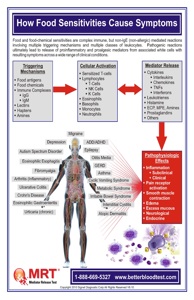Integrative Nutrition Care
Both food allergies and food sensitivities are inflammatory reactions in which an abnormal response is produced when a particular food that you are sensitive to is eaten. In contrast, food intolerances are a result of improperly digested food that ferments in your gut, causing digestive symptoms. A
Food Allergies
Food Allergies and Food Sensitivities
common example of a food intolerance is lactose intolerance. A person lacks the ability to produce enough of the enzyme lactase, in order to breakdown the milk sugar, lactose. As a result, the person develops bloating, gas, diarrhea, and other digestive symptoms. The reaction is dose related (a small amount may not produce symptoms), and is treatable by providing the enzyme, such as a lactase-containing enzyme, or using a product in which the lactose is already broken down. This sharply contrasts with a milk allergy, in which one molecule of milk in any form can produce an allergic reaction.
A food allergy is a Type 1 IgE Meditated Hypersensitivity immune reaction, with anaphylactic shock being the most dangerous reaction. It is caused by a massive release of histamine and other chemical mediators from mast cells, triggered by the antibody IgE after exposure to the offending food or antigen. In the case of anaphylactic shock, the person will die within minutes without treatment.
Food allergies are not dose related: one molecule will cause symptoms. The reaction usually occurs within a short time of ingesting the food, as opposed to delayed hypersensitivity reactions, which can occur hours to days later.
The most common food allergies are: cow’s milk dairy, peanuts, tree nuts, shellfish, fish, soy, eggs, and wheat. The Food Allergy and Anaphylaxis Network has some handy label reading tips for these allergens at http://www.foodallergy.org/food-labels. Please note this list is not inclusive. In addition, they state, “the FDA exempts highly refined soy and peanut oil from being labeled as an allergen.” Even though the antigen in oil is different than the protein antigen in the food, there are many people with soy or peanut allergies who will react to the oil, and so I advise my patients to avoid all forms of their allergen, including the oil, to be on the safe side. Remember, one molecule can invoke a reaction.
It is highly advisable to seek the assistance of a food allergy trained health care professional if you have any food allergies. Often people with a soy allergy do not realize that many of the vitamin E supplements, and even omega 3 fish oils containing natural vitamin E (tocopherols), are sourced from soy, even though there is no soy listed on the label. The same is true of various probiotics grown in a dairy culture, which can be dangerous if you have a milk allergy. Or vanilla extract and a corn allergy. Although corn and its derivatives are not listed on the label, frequently manufacturers use corn as the source of alcohol in their vanilla. There are numerous more examples in which reading the label will not necessarily keep you safe from your allergen. A Registered Dietitian trained in food allergies and food sensitivities (such as a Certified LEAP Therapist) can help you discover these hidden sources of the food that you are allergic to.
Food Sensitivities
Food sensitivities are also immune mediated (Type 3 Immune Complex Mediated and Type 4 Cell-Mediated Hypersensitivity) reactions, but are dose-sensitive (a small amount may not provoke symptoms, but a large amount of the reactive food will). They are considered delayed onset reactions, producing symptoms from hours to days later, which make them difficult to diagnose.
In a food sensitivity reaction, the immune system identifies a food or chemical as foreign and harmful, and immune mechanisms (IgG, IgA, IgM, Complement, Sensitized T-Cells, etc.) trigger immune cells to attack. These immune cells can release over 300 different chemical mediators (histamine, cytokines, prostaglandins, etc.) to destroy the invaders. As a result, tissue inflammation and damage occurs leading to symptoms. Symptoms can include: sinus pain, congestion, sore throat, joint pain, edema, “brain fog,” depression, insomnia, GI distress (gas, bloating, diarrhea, Irritable Bowel Syndrome), headaches including migraines, skin rashes, itchiness, etc. Any area of the body can become inflamed when exposed to the offending food or chemical. See the chart on how food sensitivities cause illness. Not only does exposure to food sensitivities cause you to suffer from various symptoms, but over time this is detrimental to your immune system, and can interfere with your ability to fight illnesses and diseases.
So how do you figure out what foods you are sensitive to?
Food Sensitivity Testing:
LEAP MRT










